Uni-T UT511 Bruksanvisning
Uni-T
Multimeter
UT511
Läs gratis den bruksanvisning för Uni-T UT511 (30 sidor) i kategorin Multimeter. Guiden har ansetts hjälpsam av 20 personer och har ett genomsnittsbetyg på 4.2 stjärnor baserat på 10.5 recensioner. Har du en fråga om Uni-T UT511 eller vill du ställa frågor till andra användare av produkten? Ställ en fråga
Sida 1/30

Introduction
Uni- rend Model UT5T 11 Insulation Resistance Tester
(hereafte “the Meter”) is handheld instrumenr, a t
designed primarily make resis ance insula io to t / t n
resistance measurement.
Unpacking the Meter
The Meter includes the following items:
Table 1. Unpacking Inspection
Item
1
2
3
4
5
6
Description
English Operating Manual
One-plug t t es lead to one alliga tor
Two-plug test lead to one alligator
1.5V Battery (R14 or LR14)
Tool Box
Power adaptor (optionally,
available at extra cost)
Qty
1 pc
1 pair
1 pc
8 pcs
1 pc
1 pc
In the event you find any missing or damaged part,
please contact your dealer immediately.
Safety Information
T his Me er compliest with EN 61010-1:2010
measurement requirement: Pollution Degree 2,
measurement category CAT III 600V, CAT II 1000V
and Double Insulation
CAT II (measurement category): Test and measuring
circuits connected directly to utilization points (socket outlets
and similar points) of the low-voltage MAINS installation.
CAT III (measurement category): Test and measuring
circuits connected to the distribution part of the building’s
low-voltage MAINS installation.
Use the Meter only as specified in this operating manual,
otherwise the protection provided by the Meter may be
impaired.
Danger identifies conditions and actions that pos e
hazard(s) to the user.
W arning alerts users to avoid electric shock.
Caution identifies conditions and actions that ma y
damage the Meter and affect accurat e
measurement.
Danger
Use str me ma ec fe of in u nt a in nu noal t sp i d by
the manufactuer may impair safety features /
protection provided by the equipment. Read th e
following safety information carefully before usin g
or servicing the instrument.
Do not apply mo than re 1000VDC or 750V AC.
Do not use the Meter around explosive gas,
vapor or dust.
Do not use the Meter in a wet environment.
When using the test leads, keep your figures
away from the lead contacts. Keep your
figures behind the finger guards on the leads.
Do not use the Meter with any parts or cover
removed.
When carrying out insulation measurement,
do not contact the circuit under test.
Warning
Do not use the Meter if it is damaged or meta l
part is exposed. Look for cracks or missing
plastic.
Be careful when working above 33Vrms,
46.7Vac rms and 60Vdc. Such voltages pose
a shock hazard.
Discharge all loading of circuit under test after
measuring high voltage.
Do not change battery when the Meter is in
wet environment.
Place test leads in proper input terminals.
Make sure all the test leads are firmly
connected to the Meter’s input terminals.
Make sure the Meter is turned off when
opening the battery compartment.
Caution
When performing resistance tests, remove al l
power from the circuit to be measured and
discharge all the power.
Risk of electric shock
Equipment protected throughout by DOUBLE
INSULATION or REINFORECD INSULATION
Direct current
Alternating current
Grounding
Caution
Low Battery Indication
Conforms to Standards of European Union
Wh ing then icserv e Meter, u y se onl only the
test leads and power adaptor with the same
model number or identical electrical
specifications.
Do not use the Meter if the battery indicator
(
) shows a battery empty condition. Take
the battery out from the Meter if it is not used
for a long time.
Do not use or store the Meter in an
environment of high temperature, humidity,
explosive, inflammable and strong magnetic
field. The performance of the Meter may
deteriorate after dampened.
So c th a m d gent s be u dft lo nd ild eter hould se
to clean the surface of the Meter when
servicing. No abrasive and solvent should be
u d to p nt the su of the se reve rface Meter fr om
corrosion, damage and accident.
Dry the Meter before storing if it is wet.
International Electrical Symbols
International symbols on the Meter and in this manual
are explained in Table 2.
Table 2. International Electrical Symbols
Battery Saver (Sleep Mode)
The Meter enters the Sleep Mode and blanks the display
if there is no button press for 15 minutes. This is don e
to conserve battery powe r. ofThe Meter comes out
Sleep Mode when ON /OFF bu on istt pressed t t .wo imes
The 15 minutes timer is disabled during any insulation
resistance measurement. The time period starts
immediately following any measurement.
Battery Indication
There is a battery indicator shown on the upper left
corner of the display. Please refer to Table 3 for
detailed explanation.
Battery Voltage
8.5V or less. It means the battery is
empty, don’t use the Meter as it cannot
guarantee accuracy.
8.6V~9.0V. It means the battery is almost
empty, replacing battery is necessary.
Accuracy will not be affected.
9.1V~10.2V
10.3V or more
Table 3. Battery Indication
Battery
Indicator
The Meter Structure
Below Figure 1 and Table 4 shows the Meter front
structure and description
Figure 1. The Meter Front Structur e
1
2
3
4
5
6
7
8
9
10
11
Table 4. Meter Front Description
LCD
Arrow Button
Emergency stop
Data Clear the
Display Backlight
Button,
Arrow Button
On/Off Button
Compare Button
Insulation Resistance
Button
Voltage Measurement
Timer Button.
Low Resistance
Measurement Button
12
13
14
15
16
17
18
19
20
21
22
Test Button
Step Button
Data Store Button.
Data Recall Button
Arrow Button
Arrow Button
LINE: Resistance
input terminal
COM: Voltage input
terminal
EARTH: Resistance
input terminal
V: Voltage input
terminal
Testing leads
Below Figure and 2 Table shows the Meter sid 5 e
structure and description
Figure 2. The Meter Side Structure (Side View)
Table ide De ip io 5. Meter S scr t n
1 Safety Shutter
2 Power adaptor Input Terminal
Display
Table 6 and Figure 3 describe the display.
Figure 3. Display
Table 6. Display Description
Number
1
2
3
4
5
6
7
8
9
10
11
Meaning
Indicator for DC voltage
Indicator for data store full
Indicator for clearing
Indicator for AC voltage
Indicator for timer
Step symbol
Indicates selected pass/fail compare value
Indicates for negative reading
Timer 1 symbol
Timer 2 symbol
Data store is on
12
13
14
15
16
17
18
19
20
21
Data recall is on
Indicator for polarization index
Unit symbols
The continuity buzzer is on
Compare feature pass
Analogue bar graph
Risk of electric shock
Compare feature fail
Indicator for power adaptor
Battery life indicator
Key Functions
Table 7. Key Description
ON/OFF
CLEAR/
SAVE
LOAD
Turn on or off the Mete r. Press and hold
the button for 1 second to turn the Meter on.
Short press to clear the stored data,long
press to turn on and off the display backlight.
Press to store the current measurement
value. The maximum number of stored
reading is 18. W t sthen he ored readings
memory is full, the Meter shows FULL
and stop storing. Press CLEAR to clear
the stored value in order to store the
next measurement value.
Press d value.once to recall the first store
Press again to exit Load feature.
Load feature can only be used whe n
there is no high voltage output.
Under insulation resistance measurement mode:
press to select previous voltage range.
Under load mode: press to recall
the previous stored value.
Under insulation resistance measurement mode:
press to select next voltage range.
Under load mode: press to recall
the next stored value.
When compare function is enabled
for insulation resistance
measurement, press to decrement
a resistance comparing value.
After polarization index measurement ,
press to display polarization index,
TIME 2 and TIME 1 insulation
resistance values in sequence.
When seting the timer for the
measurement of insulation resistance
or polarization index, press to
increment the time. The maximum
length of time is 30 minutes, the Meter
will automatically carry out
measurement.
When compare function is enabled
for insulation resistance
measurement, s to increment a pres
resistance comparing value.
After polarization index measurement,
press to display polarization index,
TIME 2 and TIME 1 insulation
resistance values in sequence.
Press to display S1 S2 S3 in
sequence.
When the Meter is under timed
measurement or polarization index
measurement:
S1 means increment of 1, then
each press of
increase 1 or
decrease 1.
S2 means increment of 10, then
each press of
increase 10 or
decrease 10.
S3 means increment of 30, then
each press of
increase 30 or
decrease 30.
STEP
When setting the timer for the
measurement of insulation resistanc e
or polarization index, press to
decrement the time. The maximum
length of time is 30 minutes, the
Meter will automatically carry out
measurement.
When the Meter is under compare
mode:
S1 means increment of 1, then
each press of
increase 1 or
decrease 1.
S2 means increment of 10, then
each press of
increase 10 or
decrease 10.
S3 means increment of 100, then
ea h pc ress f o
in e 100 ocreas r
decrease 100.
Set a pass / fail limit for insulation tests.
The default value is 100M
Pres to step through continuous , timed
and polarization index measurements
in sequence.
Press to turn on/off the output of
insulation resistance test voltage.
Press to initiate insulation resistance
measurement
COMP
TIME
TEST
Ho
Press to initiate low resistance
measurement
Press to initiate voltage measurement
Lo
DVC
/ACV
Emergency stop button. Press this
button when the Meter crashes down. and
cannot turn off the power.
E-STOP
Measurement Operation
This section explains how to make measurements.
A. Measuring Voltage
Figure 4. Voltage Measurement
Black
Red
Special care should be taken when measuring
high voltage.
Caution
Warning
To avoid harm to you or damage to the Mete r,
please sdo not attempt to measure voltage
higher hthan 1000V DC or 750V AC, althoug
readings may be obtained.
To m sure v t , set t Meter as F re 4 ea ol age up he igu and
do the following:
Press or button to select DC voltage orDCV ACV
AC voltage measurement
Insert the red test lead into the terminal and theV
black test lead into the terminal.COM
Connect the red and black alligator clip to the circuit
to be measured.
During measurement, when negative voltage is
present on the red test lead, then “-“ shows on the
display.
1.
2.
3.
4.
Produktspecifikationer
| Varumärke: | Uni-T |
| Kategori: | Multimeter |
| Modell: | UT511 |
| Produkttyp: | Digital multimeter |
| Vikt: | 2000 g |
| Bakgrundsbelysning: | Ja |
| Grundläggande noggrannhet (växelspänning): | ±(1.5%+3) |
| Produktstorlek (BxDxH): | 155 x 94 x 202 mm |
| Batterispänning: | 1.5 V |
| Displaytyp: | LCD |
| Grundläggande noggrannhet (likspänning): | ±(1%+3) |
Behöver du hjälp?
Om du behöver hjälp med Uni-T UT511 ställ en fråga nedan och andra användare kommer att svara dig
Multimeter Uni-T Manualer
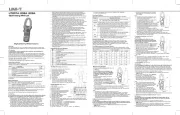
10 September 2025
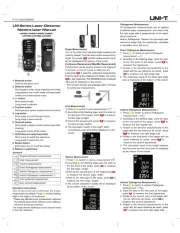
10 September 2025
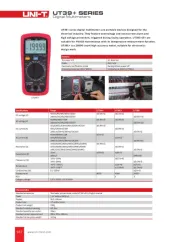
10 September 2025
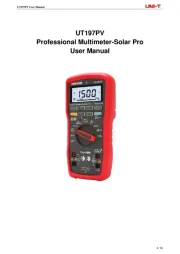
6 Augusti 2025

19 Juni 2025

18 Juni 2025

18 Juni 2025
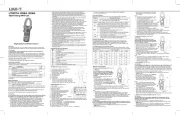
18 Juni 2025
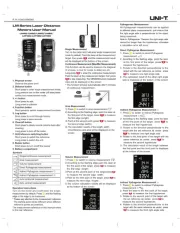
18 Juni 2025

16 Juni 2025
Multimeter Manualer
- Flir
- Qian
- GW Instek
- Weltron
- Trotec
- Horex
- Aldi
- Vemer
- Noyafa
- Stanley
- Testo
- Elworks
- Ferm
- Extech
- Testboy
Nyaste Multimeter Manualer
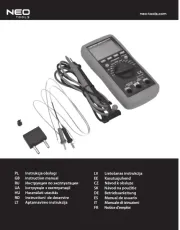
20 Oktober 2025
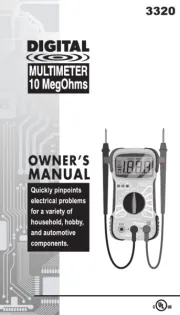
13 Oktober 2025
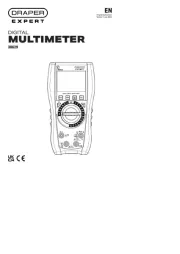
7 Oktober 2025
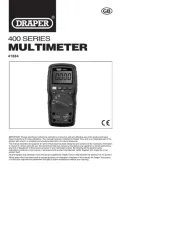
7 Oktober 2025
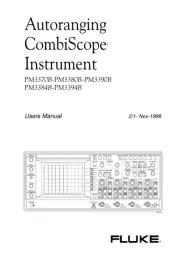
26 September 2025

26 September 2025
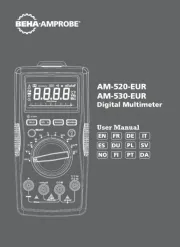
26 September 2025
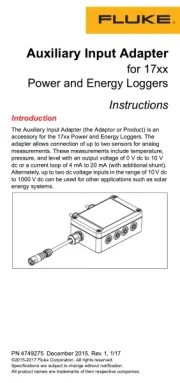
26 September 2025
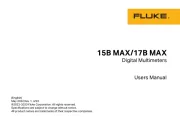
26 September 2025
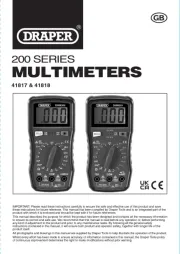
26 September 2025